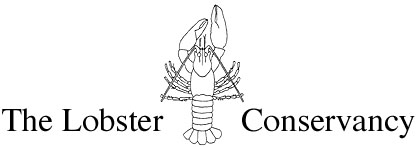
P.O. Box 235, Friendship, ME 04547 (207) 832-8224 www.lobsters.org

P.O. Box 235, Friendship, ME 04547 (207) 832-8224 www.lobsters.org
February 2004
Dear Volunteers and Friends of The Lobster Conservancy,
The Lobster Conservancy's mission is to sustain a thriving lobster fishery through science and community. This newsletter keeps our friends and volunteer research team informed of our activities. Here's what we've been up to over the past few months.
News from the Board of Directors
TLC welcomes Chris Cash to the staff! Chris has collaborated with TLC
staff over the past two years as a JLMP volunteer and as Fellowship Coordinator
at the Island Institute. In her new role as Program Manager Chris will be manning
the “Lobster House” and assisting with daily operations, so the
next time you are in Friendship please stop by and introduce yourself!
We have had a great response to our 2003 Annual Appeal! The mailing included our first Annual Report thanks to the excellent guidance of John Guarnaccia and beautiful layout by Stacy Welner of Moonlit Dream Graphics. Special thanks to the individuals and businesses who started or renewed memberships with TLC. Your support is critical to keep our initiatives strong. If you did not receive our solicitation or would like more information about our Membership Program please contact the TLC office at (207) 832-8224.
On a sadder note, our dear friend and colleague Rainer Voigt passed away recently. Rainer was a tireless researcher who focused on lobster, crayfish, and fish sensory biology. He contributed greatly to better understanding how animals use chemical signals. He was an integral part of the Boston University Marine Program (BUMP) for many years. Rainer helped the graduate students of BUMP succeed with their studies and research, including TLC board and staff members Diane Cowan, Kari Lavalli, Sara Ellis and Linda Archambault. Rainer was also a wonderful mentor to many other biologists. We will miss him.
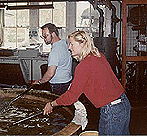
Rainer Voigt helping Diane Cowan “fish” for lobster
food at the Marine Biological Laboratory in Woods Hole.
Research News
Juvenile Lobster Project
Long-term Juvenile Lobster Monitoring
TLC continues its monthly lobster census at three coastal sites in Maine. December
of 2003 marked the end of our 11th year censusing juvenile lobsters in Harpswell
– and our 5th year at Friendship Long Island and Allen Island sites. Lobsters
are tagged at each of these sites to generate information on growth rates, movements
and survivorship. For a summary of last year’s work here is Diane’s
February Lobster Doc article.
(Reprinted with permission from Commercial Fisheries News)
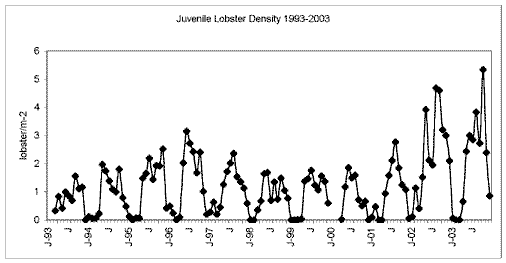
Monthly abundance of juvenile lobsters at near-shore long-term
monitoring site in Harpswell, Maine.
The Lobster Conservancy has been censusing a group of lobsters at a site in
Harpswell, Maine since 1993. In 2003, the abundance of juvenile lobsters hit
a record high – surpassing the last record count established in 2002.
Juvenile lobster abundance at Friendship, Maine - one of two additional sites
sampled on a year-round basis – was similarly high. At both sites, annual
peak lobster densities (averaged for each month) varied from a little less than
2 to greater than 5 lobsters per meter squared. Actual numbers per meter squared
are as high as 11-13 during settlement.
In general, high years for one age class have been high years for the other age classes. Settlement densities and abundance of first-year lobsters were also record high in 2002 and 2003. Settlement means that postlarval lobsters have made the journey from surface waters to “settle” on the bottom. The stage that settles grows on to the next stage within hours or days of settlement and cannot be included in the next month as a bigger lobster. Settlement typically occurs during late summer or early fall. In 2003, the period of time for settlement was prolonged from July through December.
Picking out trends from pinpoints of data can be tricky. Data from just one or two locations or times of year can be misleading. To deal with these potential pitfalls, samples are taken over an extensive temporal and spatial scale. The Lobster Conservancy covers a broad geographical area by training a team of 90 volunteers to census 25 additional lobster nurseries in Maine, New Hampshire and Massachusetts. Volunteers for the Juvenile Lobster Monitoring Program measure lobster abundance from April – November. Trends in abundance have been similar among sampling sites with sites in Casco Bay, Midcoast Maine and Massachusetts Bay yielding consistently higher juvenile lobster densities than other areas
Keeping track of the same lobster nurseries month after month and year after
year, leads to a better understanding of the relative importance of specific
habitats. The JLMP identifies and quantifies the abundance of lobsters at specific
nurseries. Hopefully, habitats supporting lobster settlement and early growth
will be deemed worthy of protection from environmental degradation with the
assistance of such long term data.
Keeping track of trends in juvenile lobster abundance may also serve as an indicator of future abundance of adult lobsters destined for the fishery. As a common sense guideline, this is worth looking at. However, reliable measures of adult abundance – such as trawl surveys – are needed to link the number of juveniles to the number of adults in a population.
Volunteer-based Juvenile Lobster Monitoring Program
In 2003, more than 90 volunteers monitored 25 sites from Downeast Maine to Boston
Harbor. On the lowest tides of the month, these dedicated citizen scientists
were out tallying up the juvenile lobsters along the shoreline. After facing
some challenging sampling in August and September due to a combination of unfavorable
tides, storm surges and onshore winds, our volunteers were rewarded with favorable
October tides and an abundance of lobsters. Sites with the highest densities
in October included Gerry Island in Marblehead, MA with 43 lobsters ranging
in size from 9-60 mm carapace length (CL), Potts Point, in South Harpswell,
ME with 28 lobsters from 7-47 mm CL, Fort Stark in New Castle, NH with 21 lobsters
from 9-54 mm CL, and Pratt Island in Southport, ME with 19 lobsters ranging
from 11-64 mm CL. The majority of our volunteer teams sampled in November, which
illustrates the dedication and hardiness of our volunteers. Although most volunteers
who sampled in November found no lobsters at all, volunteers at five sites (Gerry
Island, Gun Point, Odiorne Park, Pratt Island, and Cundys Harbor) found recently-settled
juveniles, ranging in size from 8-11 mm CL – that translates into less
than one inch in overall length!
We are sorry to say goodbye to Judy and Frank Haims, who have volunteered at Gun Point in Harpswell since 2000. Please contact Jane Roundy or Sara Ellis if you know of anyone interested in becoming part of a new team at Gun Point in Harpswell. Farewell and thanks also to volunteers Margaret Stone and Brook Vail who sampled at Lowells Cove and to Carolyn Bryant and Don Sarles who sampled at Round Pond.
Linda Archambault is looking for a dedicated female volunteer to help her conduct juvenile lobster sampling on Allen Island (a beautiful island in outer Muscongus Bay, Maine with free roaming sheep and wonderful wildlife). If you can commit to monthly sampling, or would like more information, please contact Linda at linda@lobsters.org or (207) 832-8224.
We thank the Bruce J. Anderson Foundation, Maine Community Foundation, National Fish and Wildlife Foundation, and New England Biolabs for providing funding in 2003 to develop our online JLMP database application. Kudos to Sean and Laura Creagan of db-ology for creating and maintaining the application. Volunteers have done an excellent job with inputting the data online, and they have appreciated the ability to graph and track their site records. Preliminary findings of the 2003 volunteer data will be available shortly. Planning is underway for the 2004 sampling season. Our annual Pre-Season Kick Off Meetings will be held in Friendship, ME on Saturday April 3, and Portsmouth, NH on Sunday April 4, so volunteers, mark your calendars!
Comparative Study on Lobster Abundance
Because the intertidal zone is the most landward margin of lobster distribution,
there has been concern that abundance data gathered in the JLMP might not be
representative of patterns of abundance occurring subtidally. TLC has begun
to address this question directly with a 3-year study at three island lobster
nurseries in Casco Bay and Muscongus Bay, Maine. One of the main goals of this
project is to compare lobster abundance in adjacent intertidal and subtidal
lobster nurseries, using similar methodologies in both habitats. To do this
Linda Archambault, TLC’s Research Coordinator, developed a SCUBA-based
research program for censusing lobsters underwater.
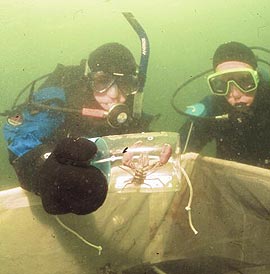
Linda Archambault and Andrew Mountcastle collect a lobster from
a 1-m2 quadrat fitted with a weighted mesh skirt. (Photo by Nick Caloyianis)
Between June and November 2003 Linda and her team of divers conducted monthly lobster surveys in the subtidal zone by diving at 5m below mean low water, gathering data on lobster size and abundance at Lowells Cove, Friendship Long Island, and Allen Island. When we compared these data with our intertidal surveys (at a depth of 0.3m below mean low water), the general pattern was remarkably similar. The similarity broke down in November, at which point subtidal density continued to climb while intertidal density decreased (see graph), suggesting that lobsters began migrating from intertidal to subtidal habitats in response to colder weather and/or storms.
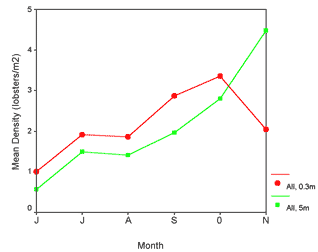
Monthly abundance of lobsters at 0.3m and 5m below mean low
water at three sites, Jun – Nov 2003.
We also found a strong positive correlation (r = 0.65, p = 0.04, n = 10) between lobster abundance in adjacent intertidal and subtidal sites during summer and early fall, i.e., locations supporting high or low lobster densities in the intertidal zone corresponded to locations supporting high or low lobster densities in the subtidal zone. The finding that intertidal/subtidal patterns of abundance are strongly correlated in summer and early fall is important, since it strengthens our earlier finding (Ellis and Cowan 2001) that data collected in the intertidal zone are indicative of general patterns of juvenile lobster abundance in the subtidal zone. This reinforces the idea that the JLMP can serve as a low-cost, logistically simple method that can complement SCUBA-based sampling to provide greater temporal and spatial coverage of juvenile lobster abundance and distribution. (For more information on this project, you will soon be able to read our full progress report to Up East at www.lobsters.org/research/research.html.)
Lobster Life Studies Center
John Valaitis donned his dry suit and took a look at Aeolidia’s winter
mooring to assess any possible damage caused by last winter’s ice. The
huge granite block had been overturned. John and Diane righted the mooring and
moved it back to where it is once again surrounded by ice. Thanks John –
it looks like we may have to repeat this episode!
Miles and Stephanie Jamieson continue to provide constant invaluable support maintaining the buildings and grounds at the Lobster Life Studies Center. Thank you!
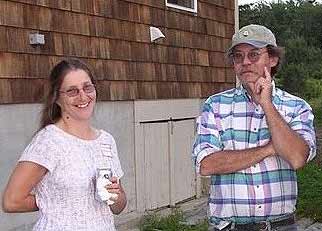
Miles and Stephanie Jamieson at the Lobster Life Studies Center,
Summer 2003 (Photo by Sara Ellis)
Sonar Tracking Project
We recently trained three new harvesters to track sonar tagged lobster: Richard
Barter, Troy Hayes, and Tim Thompson. They are doing a terrific job and along
with the other active trackers have followed the movements of 93% of the lobsters
outfitted with transmitters in 2003. 96% of all egg-bearing females and 85%
of males have been relocated at least once since they were tagged last summer.
Richard Nelson F/V Pescadero, Troy Hayes F/V Grey Ghost, Diane and Andrew participated in GIS workshop Nov 13 & 14 to hone their skills in mapping lobster movements. Thank you to the Island Institute and Peaks Island Neighborhood Association for organizing this workshop and to MBNA for supporting it.
In early November we were joined by our friends Clarita Berger and Nick Caloyianis, highly accomplished underwater filmmakers, for an intensive week of diving. They assisted Linda and Andrew in testing Sonotronics prototype dive-model hydrophone receiver, searching and successfully locating two of our sonar tagged lobsters. Based on our field experience, the receiver has since been modified to improve its performance and we look forward to using it again soon. Many thanks to Nick and Clarita for their knowledgeable support, as well as the fishermen who provided their boats and services: Jim Bolen, Jon Murphy and Mark Havener.
Outreach and Education
Lobster Larvae in the Classroom
TLC will continue to bring the Lobster Larvae in the Classroom project to coastal
Maine schools this year. In March, Linda Archambault will travel to Isle au
Haut to work with Kathie Fiveash and teacher Joy Seaver in their multi-age classes.
Linda also plans to bring the project to Jenny Johnson’s class on Little
Cranberry Island. In May, Friendship Village School will be raising lobster
larvae for the third year in a row. Working together, Linda and teachers Carla
Eutsler and Gigi Hynd continue to improve on the project. This year, Gigi’s
class is working on an oral history project about lobstering in Friendship.
Muscongus Among Us
On January 14, the Muscongus Among Us alliance presented our second annual Share
Fair to 22 school teachers and principals. The evening’s events were intended
to stimulate collaboration between in-school and out-of-school educators in
the 9 communities around Muscongus Bay. The newly updated Muscongus Among Us
2004 Educators Guide is available. Contact Linda at linda@lobsters.org
if you would like a copy.
Fishermen and Scientists Present
Over the last few months, TLC staff and collaborators have made several presentations
on lobster biology and research (see table).
| Date |
Venue |
Title |
Presenters |
| Oct 30, 2003 | Cliff Island Community Center | Collaborative Research Between Lobstermen and Scientists | Diane Cowan, Senior Scientist, TLC Sara Ellis, Executive Director, TLC |
| Nov 11, 2003 | Waldoboro Women’s Club, VFW Hall Waldoboro |
Lobster Biology and Research | Sara Ellis, Executive Director, TLC |
| Dec 9, 2003 | Northeast Consortium Annual Meeting, Portsmouth, NH | Lobster Sonar Tracking Project | Tim Thompson, Capt., F/V Haley & Amy Diane Cowan, Senior Scientist, TLC |
| Dec 10, 2003 | Prof. Noyes-Hull Oceanography class, UMaine | Thomaston Lobster Biology and Research | Sara Ellis, Executive Director, TLC |
| Jan 5, 2004 | Mrs. Wolfe’s 5th grade class, Camden/Rockport Middle School | Lobster Fishery and Research Technology | Linda Archambault, Education & Research Coordinator,
TLC Andrew Mountcastle, Island Fellow, TLC |
| Jan 17, 2004 | Fishermen’s Families for Harpswell, Harpswell Grange | Possible Effects of the LNG on Harpswell’s Lobster Fishery | Amy Watson, TLC Board Member and JLMP Volunteer |
| Jan 28, 2004 | Lobster Behavior Research, Portsmouth, NH (sponsored by NH Sea Grant, UNH Cooperative Extension, and Northeast Consortium) | Tracking Lobster Migrations Using Sonar | Philip Bramhall, Capt., F/V Amanda Kate Andrew Mountcastle, Island Fellow, TLC |
Press Coverage
She’s back!! Diane returns as "Lobster Doc", writing a monthly
column in Commercial Fisheries News to educate their readership about current
issues in lobster biology. To catch all Lobster Doc articles online as they
become available go to www.lobsters.org/ldoc/ldocindx.php.
The Lobster Conservancy’s research programs made the press in the last few months, including the Washington Post (Tracking Maine’s Crustacean Bounty, by Michael Powell), the Portland Pigeon (The Lobster Industry Faces Lean Times, by Roger Berle and Lesley MacVane), and the Portsmouth Herald (Lobster Conservancy Gets Challenge Grant, by Karen Dandurant).
There has also been considerable coverage of the proposed Liquid Natural Gas pipeline in Harpswell. TLC board member Amy Watson has represented TLC at several gatherings protesting the LNG. For more information see recent articles in the Times Record; Fishing Families Group Gears Up for Sunday Open House and Fishing Families Make Their Case by Elizabeth Dorsey
And for more information on Fishing Families for Harpswell go to www.fffh.org.
Multitudes of Thanks
We are grateful to the following organizations for their generous support of
our research and related programs in 2004: Darden Restaurants Foundation, Davis
Conservation Foundation, ESRI, Greater Piscataqua Community Foundation, the
Kate Ireland Foundation, Maine Charity Fund of the Maine Community Foundation,
National Fish and Wildlife Foundation, New England Biolabs Foundation, Sella
Foundation Trust, Roger Berle Charitable Trust, Up East Foundation, and Wallis
Foundation.
Many thanks to the volunteers who helped mail out our Annual Appeal including Stefanie Alley, Bill and Lynn Case, Paul Hickey, Martha MacIlvaine, Nancy Nelson, Frances Richardson, Jane Roundy, Marguerite Sylvester, and Marie Winchenbaugh, and to Jack Boak (MidCoast Stewards, class of 2003) for keeping our membership database up to date. We were honored that Legal Sea Foods offered a generous premium to help build our membership.
Upcoming Events
The annual Maine Fishermen’s Forum will be held at the Samoset Resort
in Rockport, ME March 4-6th. We are looking for volunteers to help man TLC’s
booth Friday or Saturday in 2-4 hour segments. Please call 207-832-8224 or email
Chris Cash at chris@lobsters.org. For
more information about this year’s forum go to www.mainefishermensforum.org.
Mark Wallace (F/V Pamela B) will appear as one of the fishermen involved in Collaborative Research Project Panel 10:30- 12:00 on Friday March 5th at the forum. He will speak about his participation in TLC’s Sonar Tracking Project. Mark will use equipment enhanced by Island Fellow Andrew Mountcastle and a rubber lobster tagged by Philip Bramhall to demonstrate how hydrophones are used to track sonar-tagged lobster from fishing vessels. (Sponsored by Northeast Consortium.)
Diane Cowan will also present at the Fishermen’s Forum. She will be one of the speakers for the panel discussion entitled, Breaking Down the Barriers; Fishermen, Scientists, and Media on Saturday March 6th from 10:30-12:00. (Sponsored by Maine Sea Grant.)
On March 30th Sara Ellis will present “Lobster Life Cycle: From Egg to Plate” at Boothbay Adult Education.
Muscongus Among Us is offering a workshop of eight interrelated yet independent evening programs on topics related to Muscongus Bay (UMaine Cooperative Extension Offices in Waldoboro, Tuesdays, 6:30-9:00 PM, March 2 to June 1). Each program will be open to area educators from all local schools and grades, and participants may take one or all of the programs at no cost. TLC’s contribution to the series will be “The Ins and Outs of Lobster Anatomy” and will include a lecture on the external and internal anatomy of our favorite crustacean. For more information, contact Jennifer Atkinson at jatkinson@qlf.org or 207-832-6162.
TLC's Wish List
If you can spare any of the following items, we would be happy to give them
a new home, providing they are in good working order. The value of your donation
would, of course, be tax deductible. Please call us at 207-832-8224 about a
potential donation.
As always, your support will be most appreciated!
And while we’re on the subject of exchanging items, TLC has a lobster boat for sale. The 24-ft vessel (fiberglass over wood) had a new engine and electronics installed in 2002; our asking price is $10,000 (or best offer). The boat can be viewed at Lash’s boatyard in Friendship, or call (207) 832-8224 for more info.
Yours in TLC and Friendship,
Sara Ellis, Executive Director and Diane Cowan, Senior Scientist